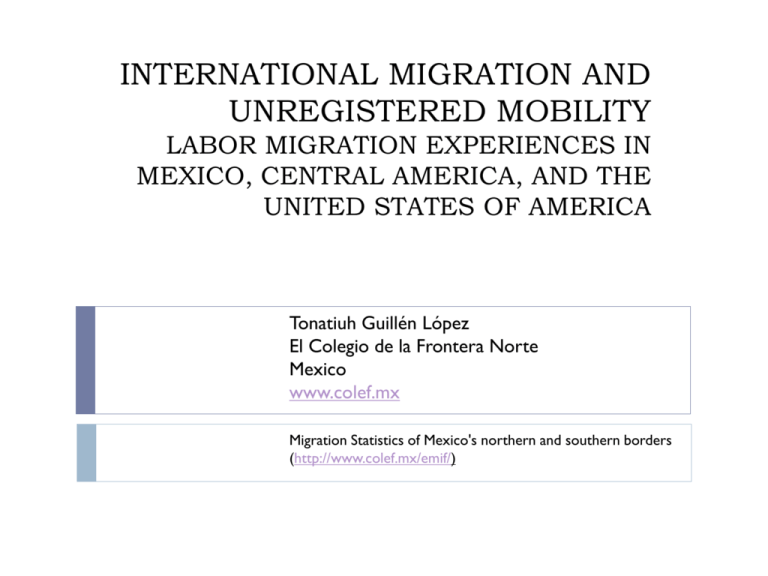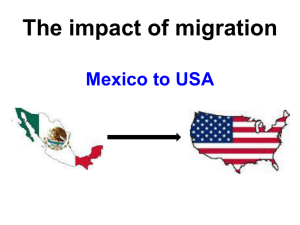international migration and unregistered mobility labor
advertisement

INTERNATIONAL MIGRATION AND UNREGISTERED MOBILITY LABOR MIGRATION EXPERIENCES IN MEXICO, CENTRAL AMERICA, AND THE UNITED STATES OF AMERICA Tonatiuh Guillén López El Colegio de la Frontera Norte Mexico www.colef.mx Migration Statistics of Mexico's northern and southern borders (http://www.colef.mx/emif/) This presentation aims to examine the world's largest international migration, integrated by citizens from Mexico, Guatemala, Honduras, and El Salvador bound for the United States of America. Historically, such movements have been undocumented and largely motivated by labor factors. This type of migration implies serious challenges to measuring and understanding the living and transit conditions that these populations face. It also reveals the existing tension between these countries' migration policies and the exercise of fundamental human rights. International migration: between development and basic human challenges It is widely recognized that international migration is a major force of social change in modern societies, for sending and receiving countries. In parallel with the global economy, international migration gradually leads toward a more interdependent, connected, and multicultural global society. Albeit with a universal history, human mobility has intensified in the last couple of decades. With an uneven global and regional pace, in general, international migration results in positive social development and growth for the countries, donors and hosts. Some of the major challenges migrant populations are facing include: national migration policies; the economic cost of migration; their documented or irregular conditions; cultural and family transitions for migrants; and the protection of their rights. The relevance for these challenges is particularly significant for SouthNorth migration (in terms of the IOM/UN) and is clearly reflected in the experience of migrants from North and Central America. Labor migration from Mexico to the United States of America Mexican labor migration to the United States represents the largest migration in the world; moreover, this movement is concentrated in a single country. With long historical roots based on a large-scale labor markets, Mexican migration originally was centered around unskilled labor (agriculture) and has evolved to cover other sectors that require semi-skilled and skilled labor (construction and service activities, primarily). Currently, 10% of Mexicans born in Mexico live in the United States (about 11.6 million), and more than half of them have no legal documentation to reside or work in this country. This situation reflects an important dichotomy in United States: an economic structure that demands workers; and an immigration policy that excludes and fails to recognize them. The result is the massive informal dimension of this labor market, jointly with an informal migration process, which usually involves clandestine border crossings (79% of 865 thousand crosses in 2007 were undocumented; 60% of 250 thousand crosses in 2013 were also undocumented). The global economy without a global labor market (NAFTA) Paradoxically, the governments of the United States and Mexico (along with Canada) have developed a successful free trade market (NAFTA), which had not incorporated the transnational labor market into their agreements. The economies of the three countries are now more interdependent: Mexico is the third largest trading partner of the United States (after Canada and China). With its formal and informal dimension, the transnational labor market is part of the same economic network. While Europe has moved towards an integrated economic and social structure, including internal labor mobility and greater receptivity to migration from other regions, in North America predominates the simultaneous exclusion and use of migrant labor. In addition, US borders remain as physical barriers -increasingly hardened by national security arguments, with more walls and surveillance systems-, which impact the mobility of undocumented people. About 450 people die every year in their attempt to cross the border, doing so in dangerous conditions. Migration from Central America to Mexico On its southern border, Mexico has a contradictory situation regarding labor migration of citizens of Guatemala, El Salvador, Honduras, that are going to the United States; and for those working in Mexico's southern border region. Our country has a restrictive immigration policy for Central America, which favors that most of the transit through Mexico to the United States is not documented (about 250,000 people in 2005; 100 thousand in 2012). The vulnerability of these people is very high, due to their underground transit conditions, which includes the use of a high-risk cargo railroad, called The Beast; and they are often attacked by groups of traffickers. On the other hand, on the southern border of Mexico thousands of citizens of Guatemala work mainly in agriculture (about 600 thousand crossings had this motivation, in 2013), with minimum working documentation and precarious economic and social conditions. In many aspects, Mexico’s migration policy towards Central America is similar to the US migration policy related to Mexican labor workers. Statistical estimates, without identifying individuals The important component of undocumented labor flows from Mexico and Central America, as well as the illegal residents in the United States, are large populations in vulnerable conditions and difficulties for exercising their rights: human rights, labor and integration to development. The governments of these countries do not know the identity of migrants. Mexico, Guatemala, Honduras and El Salvador have no record of people who migrate temporarily or permanently; same situation is for those in transit. United States also does not have accurate records of these populations. Population censuses and surveys are available, especially in the United States and Mexico, and allow estimating the size, location and flow of these migrants. But they are insufficient to identify people. Partially, people identification occurs along with repatriation events: those made by the United States (of Mexican and Central Americans citizens) and Mexico (Central Americans citizens). For its part, the Central American countries can identify their citizens when they receive them. Repatriation and human costs The repatriation of Mexicans and Central Americans citizens has been a hard part of the informal labor market. It has been a customary practice of the US and Mexico governments. Until 2005, 91% of returnees had hours or days of entering the United States (of 513,000 returns); in 2013 this percentage reduced to 50% (of 350 thousand people). This change in repatriations is due to the new strategies of detention arising from the policies of national security of the US (implemented by the Department of Homeland Security and Immigration and Customs Enforcement). The new security policy of repatriations is now expelling residents, regardless of the years of life in the US and without any concern about family situations. The most serious situation is the repatriation of people who leave children in the US. In 2011, about 70 thousand people repatriated to Mexico reported that left U.S. citizen children. The separation of families is now a common consequence in the new politics of repatriation of US. Towards the future: regional policy and regional statistical systems Is needed a regional perspective of migration policies, based on agreements between the U.S., Mexico and Central American countries. The ideal goal is a formal and regulated transnational labor market. The priority is to document and identify people that migrate, to protect and guarantee their rights, including those who now reside illegally in the United States and Mexico. The most likely effect would be the economic and social development of these countries and security for the people; this alternative fulfills the expectations of national security, current priority of the US government. For statistics on migration, the main source would be the administrative records, and not the survey estimates or long temporary census, as it is at present. For now, the priority is an agreement that permits a regional system of migration statistics. It is important to have an observatory of its ongoing dynamic in US, Mexico and Central America, charting the conditions of life and mobility of people, focused on formal and especially on the undocumented people.





